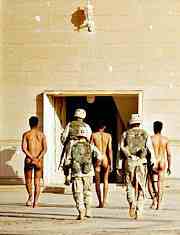Home > Forced Nudity of Iraqi Prisoners Is Seen as a Pervasive Pattern, Not (...)
Forced Nudity of Iraqi Prisoners Is Seen as a Pervasive Pattern, Not Isolated Incidents
by Open-Publishing - Thursday 10 June 2004Edito Wars and conflicts International Prison

Tomm W. Christiansen/Dagbladet
Iraqis picked up for looting weapons were marched naked through a park into a building after their clothes were burned by American troops in April 2003. They were then freed and chased naked onto the street.
SEXUAL HUMILIATION
By KATE ZERNIKE and DAVID ROHDE
In the weeks since photographs of naked detainees set off the abuse scandal at Abu Ghraib, military officials have portrayed the sexual humiliation captured in the images as the isolated acts of a rogue night shift.
But forced nudity of prisoners was pervasive in the military intelligence unit of Abu Ghraib, so much so that soldiers later said they had not seen "the whole nudity thing," as one captain called it, as abusive or out of the ordinary.
While there have been reports of forced nakedness at detention facilities in Afghanistan and at Guantánamo Bay, Cuba, the practice was apparently far more aggressive at Abu Ghraib, according to interviews, reports from human rights groups and sworn statements from detainees and soldiers. The detainees said leaving prisoners naked started as far back as last July, three months before the seven soldiers now charged and their military police company arrived at the prison. It bred a culture, some soldiers say, where the abuse captured on film could happen.
Detainees were paraded naked past other prisoners and guards; some were ordered to do jumping jacks and sing "The Star-Spangled Banner" in the nude, according to a several witnesses. Also, a father and his grown son were stripped, then forced to stand and stare at each other. The International Committee of the Red Cross, visiting in October, found prisoners left naked in their cells for days, modestly trying to shield themselves behind cardboard from meals-ready-to-eat boxes.
It is not clear how the practice emerged and, if it was official policy, exactly who authorized it. Col. Thomas M. Pappas, the military intelligence officer in charge of interrogations at the prison, told Army investigators that detainees might be stripped and shackled for questioning, but not without "good reason." When Red Cross monitors expressed alarm about prisoners being left in their cells or forced to move about naked, they said military intelligence officials "confirmed that it was part of the military intelligence process."
"It was not uncommon to see people without clothing," Capt. Donald J. Reese, the warden of the tier where the worst abuses occurred, told investigators in a sworn statement in January. "I only saw males. I was told the `whole nudity thing’ was an interrogation procedure used by military intelligence, and never thought much of it."
An analyst from the 205th Military Intelligence Battalion, who asked not to be identified for fear of being punished for speaking out, said: "If you walked down through the wing of the prison where they were being held, they would have them strip down naked. Sometimes they would stand on boxes and would hold their arms out. That happened almost every night - having them naked. I wouldn’t say it’s abuse. It’s definitely degrading to them."
Soldiers said at least one civilian interrogator, Steven Stefanowicz, had been so alarmed by the use of nudity that he reported a military intelligence interrogator after she made a detainee walk naked down a cellblock to humiliate him. His lawyer said Mr. Stefanowicz, who an Army report said might have been "directly or indirectly" responsible for abuses, had not thought stripping detainees was an appropriate interrogation technique, and had worried that doing so would incite more unrest at a time when guards were fending off rioters with live bullets.
Nudity is considered particularly shameful in Muslim culture, a violation of religious principles. While nudity as a disciplinary or coercive tool may be especially objectionable to Muslims, they are hardly the only victims of the practice. Soldiers in Nazi Germany paraded naked prisoners in daylight, and human rights groups have documented the use of nudity during conflicts in Egypt, Chile and Turkey, and in Afghanistan during the Soviet occupation. Central Intelligence Agency training manuals from the 1960’s and 1980’s taught the stripping of prisoners as an interrogation tool. Nudity and sexual humiliation have also been reported in American prisons where a number of guards at Abu Ghraib worked in their civilian lives.




